
The Power of Dexit’s AI-native Data Extraction and Classification
Picture this: your healthcare team is drowning in a sea of documents—sorting, categorizing, and manually …
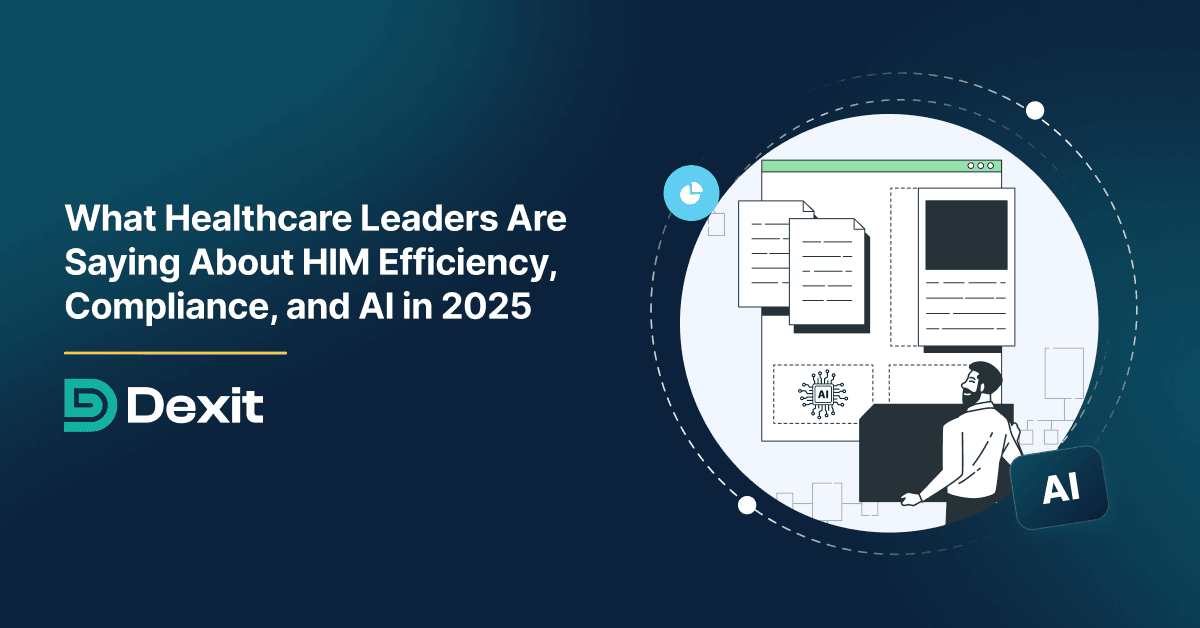
Healthcare information leaders today are caught between two pressing realities - an unprecedented surge in clinical documents and the unrelenting pressure to stay compliant, efficient, and connected across systems.
To understand how organizations are coping, CHIME and 314e conducted a joint survey on a sample population of CIOs and HIM leaders in the U.S. This survey uncovered candid insights into the state of Health Information Management (HIM) in 2025.
The findings paint a clear picture: health systems are grappling with massive volumes of medical records, yet many HIM teams continue to rely on manual data entry, classification, and extraction workflows that drain productivity and heighten compliance risks.
Yet, amid these challenges, a shift is underway. Healthcare leaders are increasingly recognizing automation and AI - not as distant possibilities, but as practical enablers to reclaim time, improve accuracy, and enhance compliance integrity.
This article explores what HIM leaders revealed through the CHIME-314e 2025 HIM Survey. It uncovers the latest HIM trends, data classification bottlenecks, compliance challenges, and how AI and Intelligent Document Processing (IDP) are reshaping the future of healthcare data management.
Despite years of EHR adoption, manual HIM processes continue to dominate daily operations.
According to the CHIME-314e 2025 HIM Survey, the most time-consuming activities reported include:
Among these, ‘data entry and extraction’ received the highest number of responses, highlighting it as the biggest productivity bottleneck.
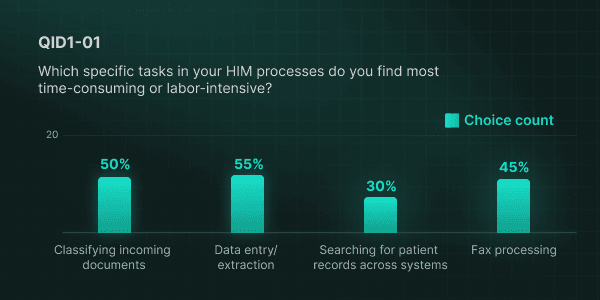
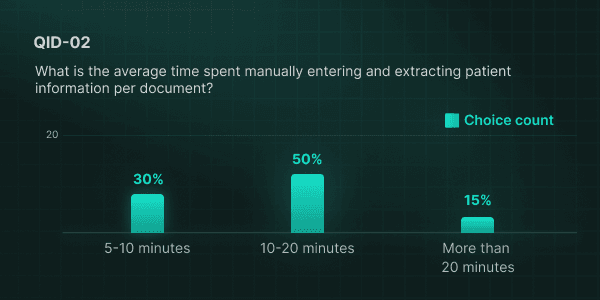
Even as healthcare organizations digitize more records, HIM compliance and data accessibility remain persistent pain points. Respondents in the CHIME-314e 2025 HIM Survey identified the following as the top three barriers to accessing patient records across systems:
Among these, inconsistent data formats received the highest number of votes, emerging as the most significant barrier to seamless data access.
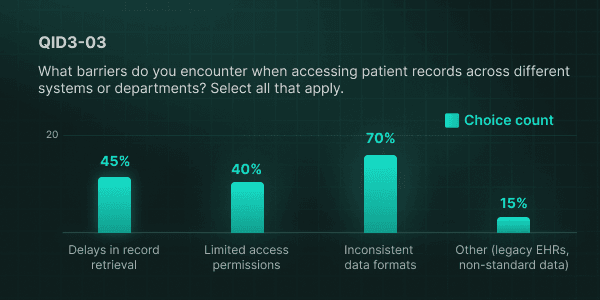
These issues don’t just slow workflows - they heighten compliance risk. HIM professionals must adhere to HIPAA and HITECH regulations while managing fragmented data spread across multiple EHRs and legacy systems.
Survey comments revealed that multiple EHRs, legacy systems, and disparate document management tools have created an environment of “incomplete visibility.” Nearly all leaders expressed concern about the lack of standardization in document archiving and indexing, particularly within health systems that have grown through acquisition or manage specialized care populations.
Without a unified, automated strategy for document handling, health organizations face several operational and compliance risks. Inconsistent patient record versioning can lead to confusion and errors in care delivery. Incomplete or misfiled data during audits may compromise the accuracy of reporting and hinder timely responses to audit requests. Moreover, these gaps can create compliance vulnerabilities that expose organizations to regulatory penalties and reputational damage.
In contrast, organizations that adopt AI-based data extraction automation and metadata tagging are closing the efficiency and compliance gap dramatically. According to the International Journal of Science and Research Archive (2025), AI-driven Intelligent Document Processing (IDP) has reduced medical record retrieval time from 20 minutes to under 5 seconds - a 98% improvement in efficiency. And as these models continue to learn from real-world data and user feedback, their accuracy and processing speed will only keep improving, further strengthening compliance and operational performance.
This leap in efficiency comes from automation’s ability to manage inconsistent metadata, varied document templates, manual naming conventions, and missing patient identifiers that often lead to downstream rework. Beyond speed, AI ensures stronger version control, metadata accuracy, and audit readiness.
For all the talk about digital transformation, fax remains healthcare’s most stubborn legacy process. According to the CHIME-314e 2025 survey, fax-based document intake is still the most challenging source to process, far ahead of email or scanned documents.


Even among cloud fax users, integration remains an obstacle. Respondents described their systems as “better, but still disconnected,” highlighting challenges in routing digital faxes into EHRs or automating downstream classification.
Even with ongoing digitization efforts, the contrast between traditional faxing and AI-enabled cloud faxing remains striking. In paper-based fax workflows, every document must be printed, scanned, sorted, and routed manually - a process that can easily extend for several hours, especially when dealing with high volumes or poor-quality scans. In contrast, cloud faxing integrated with Intelligent Document Processing (IDP) can complete the same workflow in 10 seconds or less per document, representing an efficiency gain of nearly 98%. This dramatic gap underscores how automation not only accelerates fax handling but also eliminates the human touchpoints that introduce delay, error, and compliance risk.
While AI dominates healthcare conference conversations, actual AI adoption in HIM remains measured. The CHIME-314e 2025 HIM Survey revealed that most of the surveyed organizations do not plan to invest in AI-driven HIM tools within the next 12 months - despite recognizing their potential impact. In fact, many respondents remain uncertain about whether or when to move forward with such investments.
Among those considering AI adoption, the majority indicated that 10–20% of their estimated IT budget is earmarked for AI, ML, or NLP-based document management solutions.
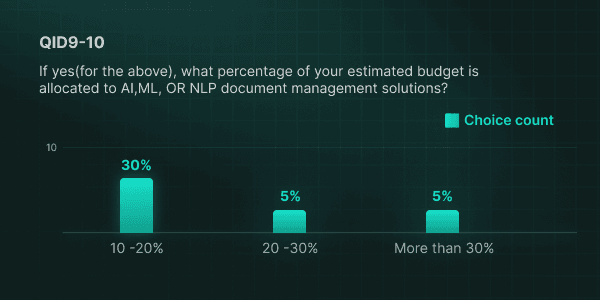
Interestingly, when asked which tasks would benefit most from automation, data extraction, document classification, and routing topped the list. These are precisely the areas where automation delivers the most measurable ROI - yet the hesitation to invest often stems from:
This hesitation is understandable. Healthcare leaders are navigating competing priorities and tight margins, and AI adoption often requires a mindset shift as much as a technology shift. But the data suggests that this caution comes at a cost.
The HIM leaders surveyed are not blind to the inefficiencies - they know exactly where the bottlenecks lie. The next phase of HIM modernization must therefore focus on improving interoperability and reducing data inconsistency through better alignment with healthcare data standards like FHIR - while introducing AI that supports, rather than replaces, human oversight.
Respondents frequently cited “time-consuming manual processes,” “lack of standards and procedures,” and “legacy systems with poor integration” as key challenges. Their feedback underscores that efficiency gains in HIM depend on addressing these integration gaps and minimizing repetitive manual steps within existing EHR workflows.
The CHIME-314e 2025 HIM Survey underscores a truth that many healthcare leaders already feel intuitively - manual inefficiencies and fragmented data workflows are no longer sustainable. HIM teams are under pressure to manage more data, faster, and with greater accuracy than ever before.
The good news? The tools to solve these challenges already exist. AI-driven document processing tools are now capable of:
When combined with standardized metadata frameworks, these capabilities can dramatically improve HIM efficiency while maintaining strict adherence to privacy and compliance requirements.
AI in Health Information Management (HIM) is no longer experimental; it’s proven, measurable, and built for compliance-sensitive environments.
Healthcare organizations that embrace automation today will not only reclaim efficiency but also strengthen data integrity and compliance resilience for the future. The message from HIM leaders is clear: they are ready for change - but they need tools they can trust.
Join over 3,200 subscribers and keep up-to-date with the latest innovations & best practices in Healthcare IT.

Picture this: your healthcare team is drowning in a sea of documents—sorting, categorizing, and manually …
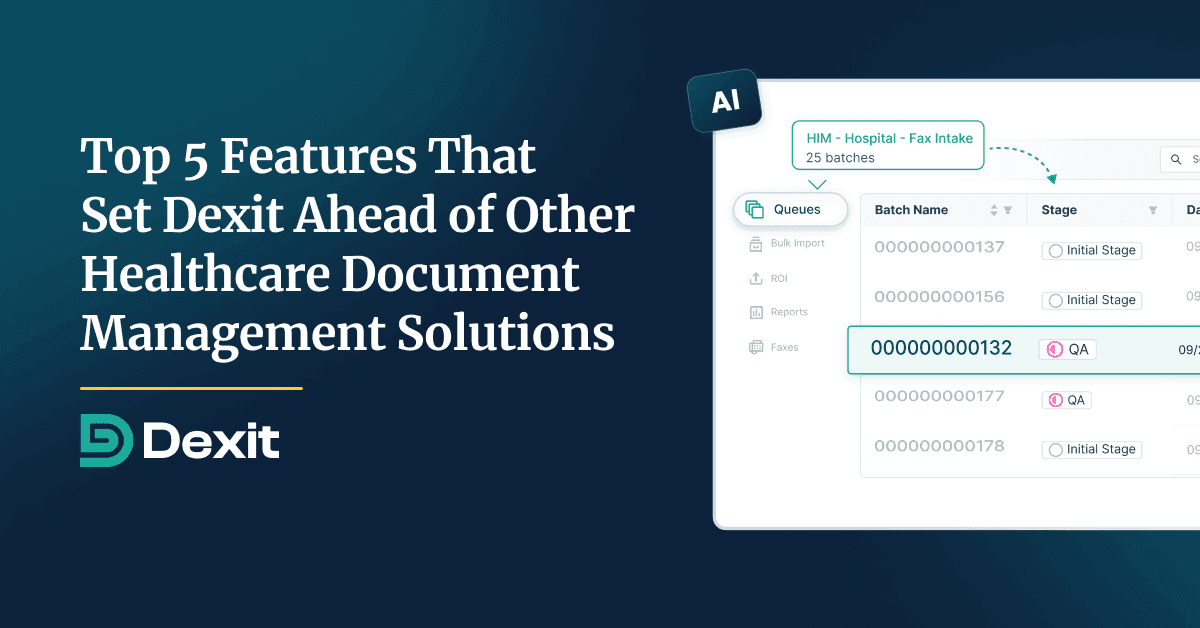
With the advent of advanced healthcare document management technologies, Health Information Management (HIM) …
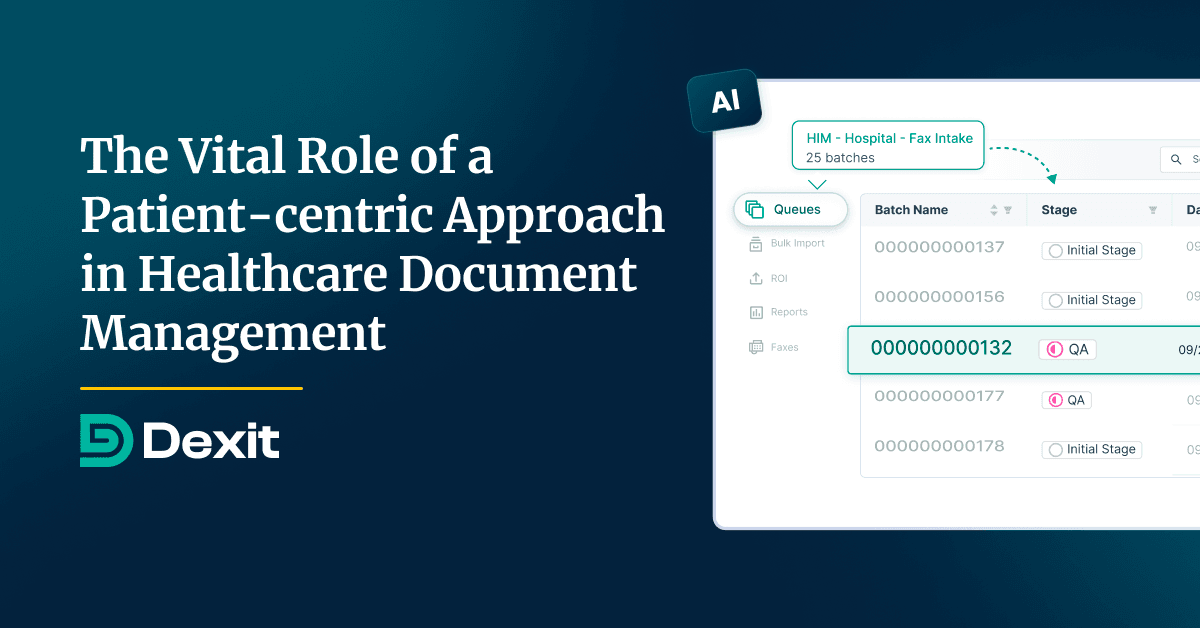
The adoption of a patient-centric approach in healthcare document management is a crucial aspect as …